
COMPARISON BETWEEN THE DOXA GMT AND THE ROLEX GMT
© Dr. Peter McClean Millar - December 2008

I hope this review does not come across as a one watch is better than the other watch. I own both of them and like them equally for different reasons but the problem with doing comparative reviews is that there is always a tendency to say one is better or one is worse and I really don't wish to do that here. I'm trying to give a pretty fair description of both watches from someone who is a fan of both Doxa and Rolex and I hope that people will read the review and gain an appreciation of both watches from it.
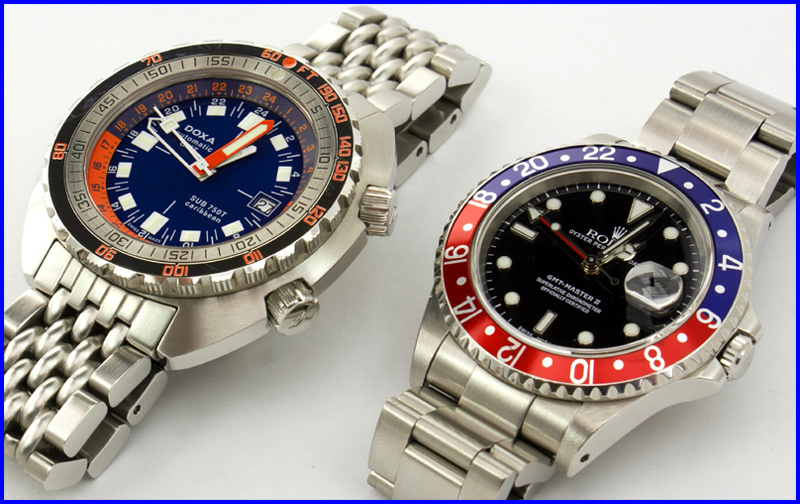
Before continuing with this review, I think it is time for a little history lesson. The Rolex GMT Master was originally designed in collaboration with Pan American World Airways for use by their long haul pilots who were traveling across multiple time zones. Pan Am asked Rolex in the 1950s to develop a watch which could tell different times simultaneously. The solution devised by Rolex was to incorporate a fourth hand which could be set to display a different time zone which corresponded with a 24 hour marking on the outer bezel. The GMT name referred to Greenwich Mean Time which was what pilots set as the second time zone. In 1972 the Aviation Industry replaced Greenwich Mean Time with Coordinated Universal Time (UTC), however, the term GMT is still used as part of the name of the GMT Master. Although initially designed as an aviation watch, today the GMT is popular with travelers and people who need to keep track of multiple time zones. The 1960ís brochure for the watch even included the following instructions for pilots on how to use the watch as an emergency compass. "In the Northern Hemisphere the Rolex GMT-Master may also be used as a compass. Simply point the hour hand towards the sun and automatically the red 24-hour hand will point to the North." In the Southern Hemisphere it will point to the South. Introduced in 1954, the design of the watch changed little over the years, with the exception of adding a Sapphire crystal and improvements in the movement. In 1981 The Rolex GMT Model 16750 added a quick set date feature. Previously in order to adjust the date, it was necessary to progress through all the dates in order to reach the desired one. The bezel insert comes in 3 flavours; red and blue (Pepsi) red and black (Coke) and plain black. Seeing the success of the Rolex GMT, other manufacturers added a GMT model to their line, the Doxa version appearing in 2006. In 2007 Rolex discontinued the "classic" GMT in favour of the larger GMT IIC. The C standing for Ceramic bezel. At present the bezel is only available in black due to an inability to manufacture a ceramic insert with an acceptable red pigment.

OK, so lets start with the one that started it all; the Rolex GMT. The version I have is the GMT Master II from 2002 (Ref. 16710). It has Solid End Links (SEL), holes in the case for the bracelet pins and uses a caliber 3185 movement. This automatic movement was introduced in 1988. It contains 31 jewels, oscillates at 28,800 beats per hour and has a power reserve of 50 hours. The bezel uses a 24-hour insert, which allows you to track time in two time zones and is split equally, red / blue, at the 6 and 18 markers. The dial uses Superluminova as luminous material. Originally Tritium was used, then Luminova and finally Superluminova from 2000 until 2007 when the model was discontinued. So if you are in the market for a Rolex GMT Master II, then unless you can find a NOS (New Old Stock) in an Authorised Dealer, you will be buying it second hand.
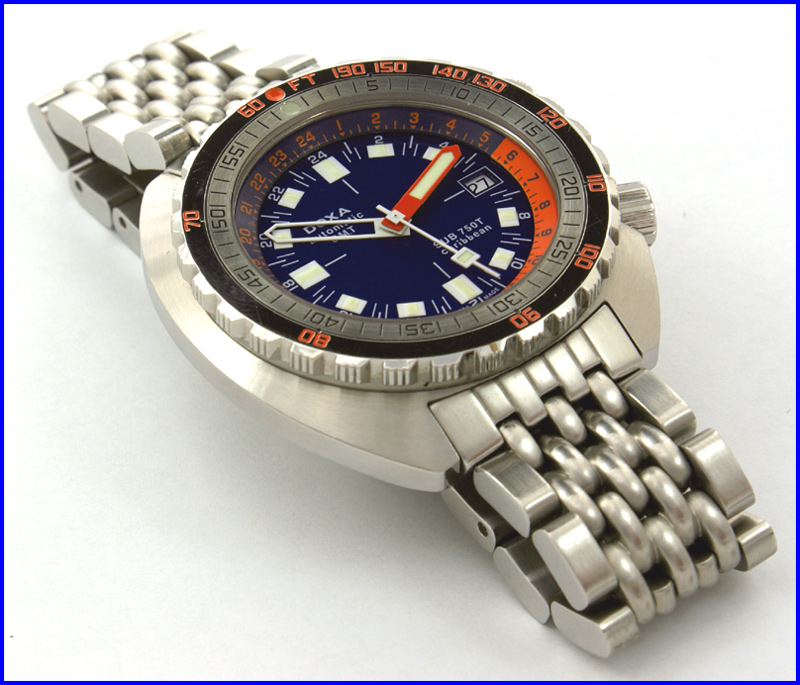
Doxa came late to the GMT party, but when they did, rather than design a new model from the ground up, they took their already successful SUB 750T design and modified it to utilize an ETA 2893-2. This is an automatic movement with hacking seconds, runs at 28,800 beats per hour and has 21 jewels. The bezel on the DOXA is the iconic NODECO bezel from the late 1960s, which gives you allowable bottom time for depth based on the US Navy Non Decompression Dive Tables. The SUB 750T GMT also uses a movable 24-hour chapter ring, which allows you to track a third time zone. Unusually the inner 24 hour bezel is split equally, blue / orange, at 5:30 and 17:30. There has never been any explanation as to why this setting was used. Personally I feel it unbalances the dial when the inner bezel is aligned at 12 / 24 hours. Full reviews of the SUB 750T and SUB 750T GMT can be found at www.doxa300t.com. The Doxa GMT comes in 4 models; Professional (orange dial), Sharkhunter (black dial), Caribbean (blue dial) and Divingstar (yellow dial).
Obviously both watches have GMT functions, which even though they have vastly different appearances, should make them pretty similar to operate. Right?...... Wrong!!! The differences between the functioning of the caliber 3185 and the ETA 2893-2 make for vastly different operations when setting the GMT hand.
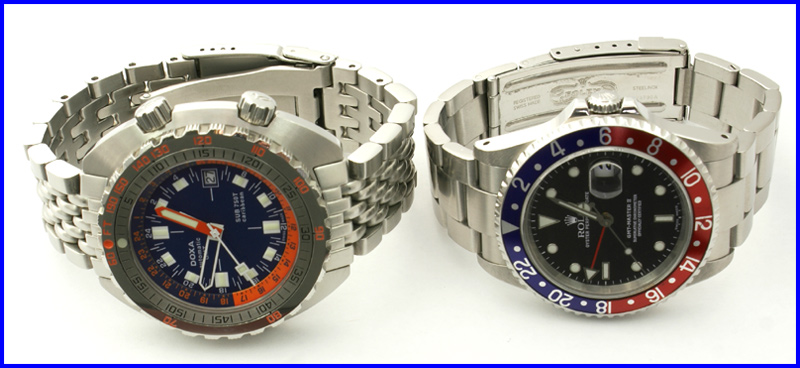
Lets use the time in the above image as an example. Both watches show that it is just after 1 o'clock PM local time. How can you tell it is 1 o'clock PM and not AM? Well, you will just have to trust me on this one. I set the GMT hand to show local time in Ireland which is 6 hours ahead of the Central USA time zone. On the Doxa it is easy to see that the skeleton GMT hand points to the 19:00 hours marker on the dial which is 7 o'clock PM. The Rolex red GMT pointer hand is sitting at the dot between 18 and 20 on the bezel. Again this is 19:00 hours or 7 PM in Ireland. Obviously the minute hand will read the correct time in both time zones. This, of course, all depends on the bezel of the Rolex being set correctly to show 6 hours in advance. The Rolex bezel can be turned bi-directionally by hand. On the original GMT Master, you couldn't set the GMT hand independently. You rotated the bezel to a different time zone instead. The independently settable hand is the big reason for the "II" designation. On the Doxa there are 24 hour markers on the dial and the inner bezel. This means that 3 time zones can be tracked. One using the normal hands, one using the 24 hour marks on the dial and one using the 24 hours indications on the inner bezel. To set the inner bezel, the upper crown unscrews and turning the crown clockwise or anti-clockwise will rotate the 24 hour chapter ring either clockwise or anticlockwise. Since in this example the inner bezel aligns with the 24 hour indications on the dial, both watches show the same time, however, setting the same time is completely different using each watch.
Lets set the Doxa first. The GMT hand is set using the lower crown. It is unscrewed and a single pull engages the GMT hour and date function. Turning the crown clockwise will advance the GMT hand in 1 hour increments. The normal hour hand will remain on local time as the GMT hand is moved. The GMT hand can only be moved clockwise because turning the crown anticlockwise will advance the date. Another pull on the crown will engage the normal hour and minute hands. The second pull on the crown will also stop the second hand from moving. It is recommended not to change the date between 10 PM and 2 AM. During that period the pinions are being repositioned to carry out the automatic date change, any interference might damage the movement.
Now for the Rolex. This is where the movements differ. Unscrewing the crown and giving a single pull engages the normal hour hand. This can be rotated clockwise or anticlockwise . The GMT hand nor the minute hand is unaffected in this position. Another pull will engage the "normal" time setting of the minute and hour hands. As the time is advanced or retarded the GMT hand will move accordingly. I have to admit that since I have owned and wore the Doxa GMT for over a year before I got the Rolex, setting the GMT hand on the Rolex seemed completely strange and, as we say in Ireland, "arse about face". I think I've got used to it now, but I still prefer the ETA 2893-2 way of doing it. Apparently there are advantages and disadvantages to both ways. Personally I prefer to set the local time then set the GMT hand to the other time zone. It just seems easier with the Doxa.

Something that isn't immediately clear from looking at photos is that it is very noticeable when picking up both watches just how much bigger and heavier the Doxa is compared to the Rolex. The following table tells the tale of the tape. Weights are in grams, dimensions are in millimeters. The height of the GMT Master is to the top of the crystal. Add 1mm extra for the date magnification bubble. The weights displayed are for a 6 3/4" wrist and as can be seen the Doxa weighs in at 184 grams, whereas the Rolex is much lighter at 122 grams. A lot of this weight is made up by the bracelet. The Rolex bracelet has center links which are not solid whereas the Doxa is completely solid. The links on both bracelets are held together by screws.
| WIDTH (inc crown) | LENGTH | HEIGHT | LUG WIDTH | CRYSTAL WIDTH | DIAL WIDTH | WEIGHT | |
| SUB 700T GMT | 45 | 47 | 14 | 21 | 30 | 26 | 184.6 |
| GMT MASTER II | 43 | 48 | 12 | 20 | 30 | 28 | 122.1 |
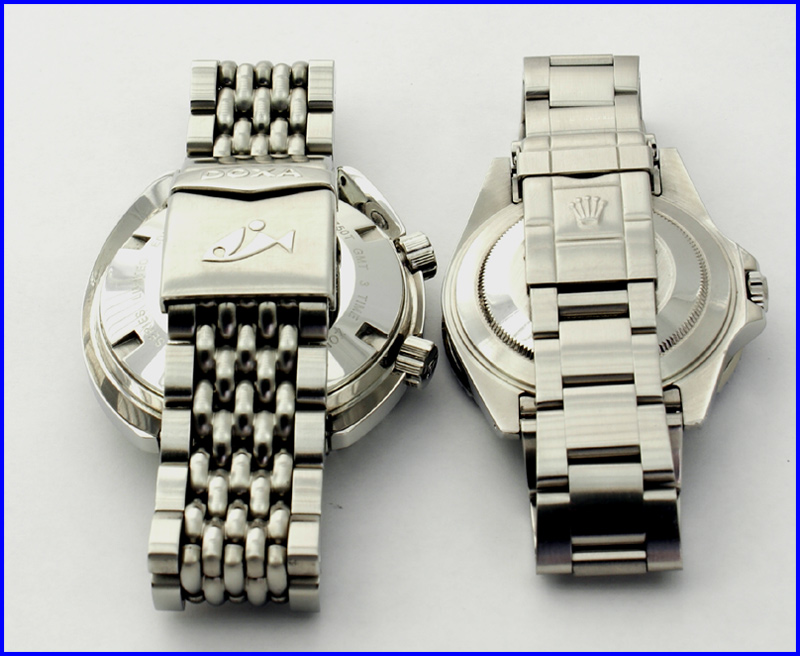
Lots of cyber ink has been allocated to discussing both bracelets, but for me there probably isn't even a discussion point here. When Doxa released the SUB 600T series they made a bracelet which looked very similar to the vintage ricebead bracelet from the late 1960s and early 1970s. However, unlike its flimsy earlier version the new SUB bracelet was very well designed and constructed and is generally acknowledged as being one of the better dive watch bracelets on the market today. It stays a constant 20mm over the whole length and there is very little lateral movement in it (the end links and lug gaps are 21mm, but the bracelet is 20mm). The Rolex bracelet starts at 20mm and reduces to 15mm at the clasp. As the center links wear and the bracelet becomes loose, a lot of lateral flexion can become apparent in the bracelet. It has remained pretty much unchanged until the release of the Sea-Dweller Deep Sea, this year. The new bracelet is a vast improvement over the version which adorns all of the older, Submariners, Sea-Dwellers and GMTs. When it comes to comparing bracelets, plain and simple, the Doxa bracelet beats the Rolex bracelet without even trying. Ooops, and here was me saying this wasn't going to be a one watch is better than the other, review..... It has long been a point of contention with Rolex Submariner owners that realistically the bracelet and clasp are thin, flimsy and "tinny". One of the best bracelets on any watch has to be that on the Seiko SKX781 or "Orange Monster" as it is affectionately known. You can pick up the bracelet for around 40 to 50 Dollars and it is superbly made and is more in keeping with a 6,000 Dollar watch than the bracelet on the Rolex Submariner. Most Rolex owners, me included, make excuses like "well it is designed for a purpose and it is unlikely to fail in that use", but honestly, how many people look at the bracelet and are inclined to think; "this is cheap and nasty?" Just tap the flip lock clasp when the watch is on your wrist. Yuck...horrible, cheap tinny sound. If the steel was any thinner, I could probably shave with it.
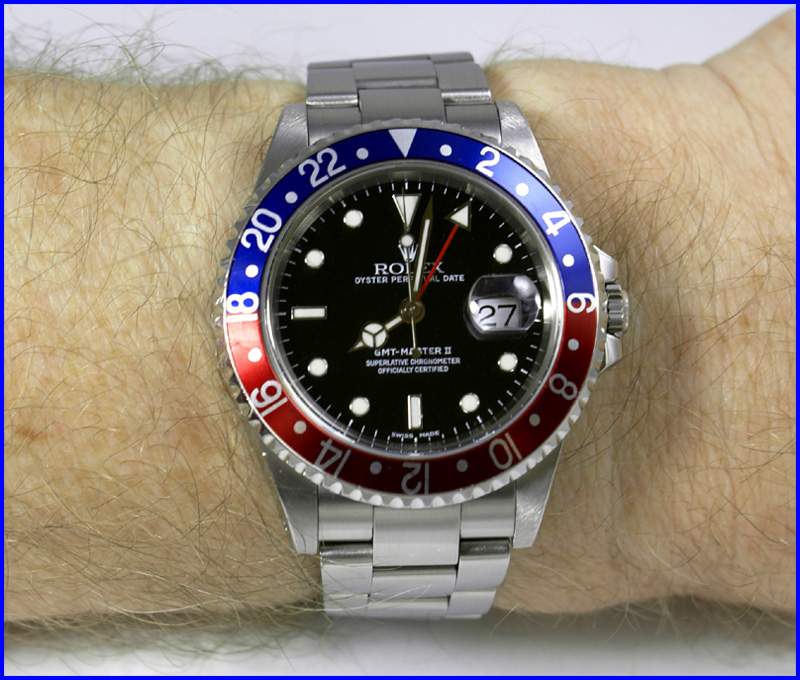
Having just slammed the Rolex bracelet, I have to say that the GMT Master II wears incredibly well. Actually, both watches are very comfortable to wear. The Rolex being thinner and much lighter is instantly comfortable and hugs the wrist like your grandmother after you gave her an 80th birthday gift.

In the case of the Doxa the extra thickness and width of the bracelet helps distribute the weight of the head evenly over the wrist, however, even though the Rolex bracelet tapers over it's length, the GMT Master II is very much in the class of put it on and forget about it. The Doxa feels a much more substantial watch but it too will quickly become "neutral" on the wrist.
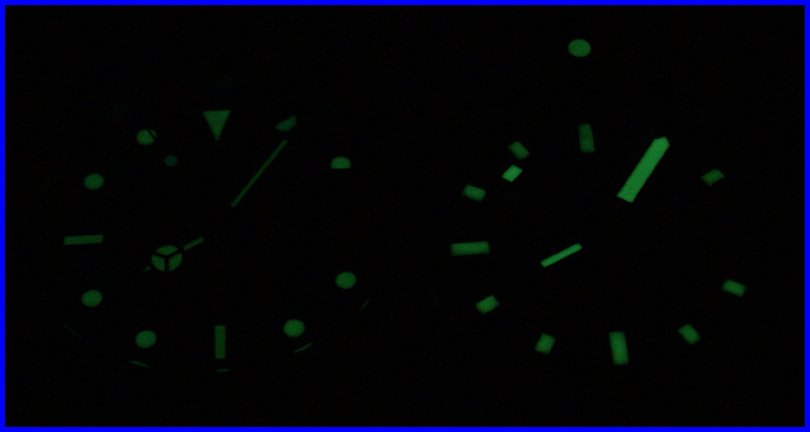
As can be seen from the images. The luminosity of both watches is very good with that of the DOXA being slightly better. This is due to the fact that there is perhaps a little more luminous material on the dial and certainly a bit more on the minute hand and also due to the difference in ages of the watches. The Rolex dates from 2002 while the DOXA was made in 2006. Both watches use Superluminova
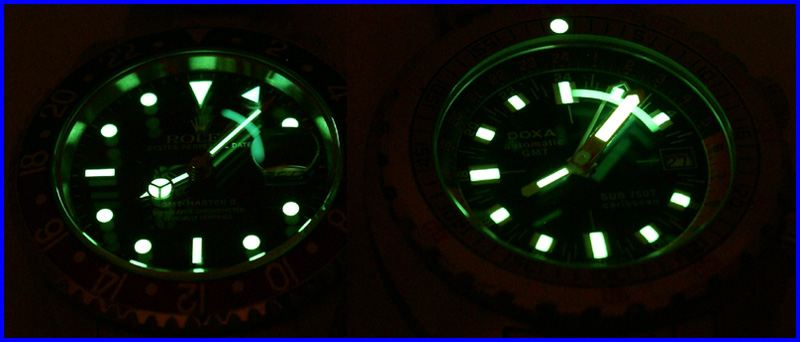
I also did a 10 second exposure to see if there would be any noticeable difference, but both show the they glow like torches.

So you are in the market for a GMT watch and have narrowed the choice down to the Doxa and the Rolex. Which one do you buy? Man, that's got to be a tough choice. Both are excellent watches. Certainly in my case both are keeping within 5 seconds a day. The Rolex using an in house movement and the Doxa an ETA caliber. It could be argued that the Doxa has dual functionality in that it also works as a true dive watch as it is based on the original 750T, which is arguably one of the best dive watches available and is rated for 750 meters. It even comes with a diver's extension built into the clasp. However, that's not to say that you couldn't dive with the Rolex as it is based on the classic Submariner and has a depth rating of 330 feet. More than enough for recreational diving. The bracelet does not have an inbuilt diver's extension, also unlike the Doxa, the GMT Master's bezel is bi-directional which means it could be moved and give an optimistically false reading if it was being used to time a dive. But lets be honest here, anyone who would use a Rolex GMT as their primary dive timing device, really shouldn't be diving. It would function as a back up at most.
Many people would chose the Doxa, just because it isn't a Rolex. Rolex, in spite of being one of the most recognisable brand names on the planet and being acknowledged as one of the best makes of expensive, sought after and respected watches carries a certain snob appeal which actually doesn't appeal to quite a number of people. The fact that Rolex watches are probably the most copied / faked in the world is a minus point for many people. One of the standard questions asked of Rolex owners is "is it a fake?" In fact, the reason I bought an older model was it had the holes in the case and it was less likely to be a fake. The Doxa on the other hand has yet to be copied and no matter where you buy one; from Doxa, a sales forum or an online auction, you can guarantee it will be genuine. Try that with a Rolex from anyone other than an Authorised Dealer and you may be in for a very nasty surprise. Next there is the simple matter of pricing. The world economy has gone down the pan. People are giving a lot more consideration to expensive purchases. A 6 year old Rolex GMT in good condition will run in the region of US$ 3200 - 4300 with box and papers whereas a 2 year old Doxa GMT will be in the region of half that. There prices are based on my observations over a couple of weeks before I bought my GMT Master. Finally there is servicing cost. Throw your Rolex in for servicing and you can kiss goodbye to anywhere from US$ 500 upwards. Admittedly when it comes back from Rolex, the watch will normally look and work like a brand new one. Servicing of an ETA based movement will run from US$ 200 upwards. It cost me US$ 250 to service a 35 years old Doxa SUB, yet Rolex wouldn't touch my wife's 34 year old Air-King, saying it was too old and I should buy another one!!!!! In the end I had a local watchmaker service it and it cost US$ 450. Ultimately I don't suppose it mattered as the watch is running perfectly and my wife is happy, but Rolex's attitude left me more than a little disappointed.

On the other hand you will have people who will buy the Rolex purely because the one thing about the Rolex that the Doxa will never have is the name Rolex. There is no doubt about the fact that wearing a Rolex brings a level of pleasure or self awareness that wearing a Doxa (or many other watches, for that matter) wont. Now maybe that sounds incredibly snobby or elitist or whatever, and maybe it is, but for many people it is true. I have to admit that as I've got older I've bought into the whole Rolex "thing". There is just something about owning a Rolex that I can't define or put a finger on. I don't associate it with any of the famous sponsors in just the same way I don't associate my Doxas with being like Dirk Pitt. I like the tie ins in both cases, certainly, but the whole sponsorship thing always seemed to be a bit false and Dirk Pitt, just like James Bond is a larger than life fictional character whereas I'm just an ordinary working drone.
As I stated at the beginning, I didn't want this to be a one watch is better than the other review. I hope it hasn't come out like that. Ultimately we buy what we like and what we can afford. That principle holds in this case. Both the Doxa SUB 750T GMT and the Rolex GMT Master II are exceptional watches and both perform their designed function effortlessly and efficiently. If I was backed into a corner and told I could have only one, which would I chose? Well before I got the Rolex, I would have said the SUB 750T GMT, but now I would have to say the GMT Master II. Why exactly is that? Well, that's a whole other story.